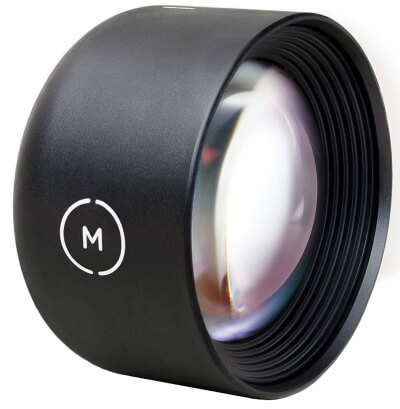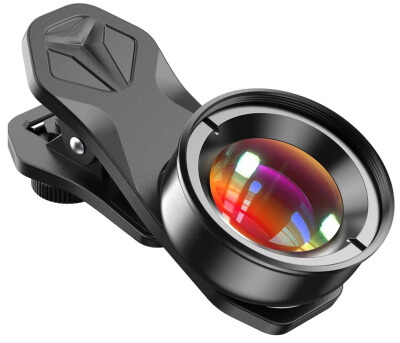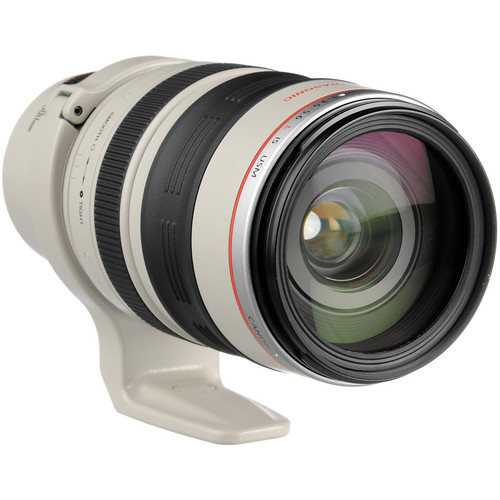Although phone cameras are getting better, they are still behind the DSLR and mirrorless cameras because of their physical limitations, and because their lens has a fixed focal length.
To understand the differences between a phone camera and a DSLR/mirrorless camera, I suggest reading my article here.
To help overcome these limitations, a clip-on lens kit or adding a new attachment lens can open up new shooting possibilities like macro, fisheye, and telephoto.
While the best camera phones now may have two or three camera configurations that include ultra-wide, standard, and telephoto lenses, you should know that the main camera is the one that has the best sensor, and using an add-on lens with this camera may give better results than using the phone’s secondary cameras.
A good starting point is to explain the limitation associated with the phone camera lenses.
You might also be interested in reading my article Why You Can’t Always Rely On A Smartphone For Professional Photography.
Focal length in a Smartphone lens
Unlike DSLR lenses with variable focal length lenses (that allow for an adjustable focal length and therefore field of view too), smartphone cameras are stuck with small, fixed lenses. This means that a smartphone camera’s focal length is fixed, leaving no option but to rely on digital zoom to close in on details in an image. Alternatively, phone manufacturers added more than one camera to the phone with different focal lengths.
For example, in the iPhone 7 Plus, Apple has opted for one 28 mm and one 56 mm lens, offering up a 2x optical zoom potential. This means that we can capture close-up shots with a 28 mm 1x zoom, and then simply switch to the 56 mm 2x zoom lens and capture pictures at greater distances without any loss in detail.
Another option is to add extra lenses to the original one to achieve different focal lengths.

Photo by Soulful Pizza
Aperture in smartphone lens
The vast majority of smartphone cameras have a fixed aperture. This means that if a smartphone is said to have an f/2.2 aperture, then that is that. You cannot change that to allow more light or less light in by adjusting the aperture.
Smartphone cameras will mostly produce photos with a deep depth of field. However, thanks to computational photography, smartphone cameras can simulate the bokeh effect (blurry background) pretty well these days.
Very few smartphone cameras have variable aperture because this is a somewhat new-ish technology, which sounds really good in theory.
The benefit of this is that if you’re taking photos in a dark environment, the camera will switch to a wide aperture in order to let in as much light as possible. On the other hand, if you’re shooting in daylight, the camera will use a narrower aperture to limit the amount of light coming in. As exciting as a variable aperture on smartphones sounds, it’s currently very limited.

Types of smartphones lenses
There are many different types of cameras you can find on a smartphone, however, chances are you won’t find every single one of them on one phone. The lens types are as follows:
Wide-angle
It is the most common type of camera found on most smartphones. Back in the days of single rear cameras, the camera had a wide-angle lens. The focal length of the wide-angle camera on smartphones ranges between 22mm and 30mm.
The wide-angle camera is ideal for capturing landscapes, group shots, or any other instance where you want to capture as much of the scene as possible.
Ultra-wide-angle
As the name suggests, the ultra-wide-angle camera has an even wider angle of view than the standard wide-angle lens. The focal of an ultra-wide-angle phone camera is generally anywhere from about 12mm to 18mm. This gives you an angle of view of up to about 120 degrees.
The downside of ultra-wide-angle lenses is that the wider their angle of view is, the more distorted the images will look around the edges. It creates a bulging effect known as a fisheye. Good mobile cameras are able to fix the distortion and give you decent results.
Telephoto
The telephoto camera on a smartphone has a much longer focal length than the wide-angle camera. In most cases, it is two or three times the focal length of the wide-angle camera. The telephoto camera on a phone can have a focal length of anywhere between 50mm to 85mm.
This is what gives a mobile camera the 2x or 3x “optical zoom” factor. They have a narrower angle of view. It is ideal for capturing portraits.
Periscope
Telephoto lenses on smartphone cameras are limited to a low zoom factor due to size. Anything more than 3x optical zoom would result in a big bulge at the back. A periscope camera on a phone usually has a focal length of, more or less, 105mm to 130mm.
Monochrome
For smartphone cameras to produce color photos, an RGB (red, green, blue) color filter array (CFA) is placed on top of the sensor. Without this filter, the camera would capture black and white images because a sensor on its own only detects light intensity, not color.
Depending on the phone, you can capture true black and white photos with the monochrome sensor as opposed to adding a digital black and white filter.
Macro
A macro lens is useful for close-up photography where you want to capture small details of the subject. A smartphone macro camera differs from the telephoto and periscope cameras in that it doesn’t zoom in on a distant subject, but rather it magnifies subjects that are close to the camera, much like a magnifying glass.
Anamorphic
Anamorphic format is the cinematography technique of shooting a widescreen picture on standard 35 mm film with a non-widescreen native aspect ratio. The anamorphic lens provides an incredible aspect ratio, it changes the dimensions of an image on one axis; allowing for a wider field of view and squeezing that same image onto a narrower sensor.
Essentially, these lenses maximize the use of the sensor by fitting more footage onto the sensor.

Best Lenses for Smartphones
In order to maximize the potential of your mobile device, you can add external lenses to get the focal length you are interested in with your favorite genre of photography.
Generally, there are two types of external lenses for your phone: clip-on and attachment.
- The clip-on lens: It clips onto the body of your phone with the lens placed right over your camera. The benefit of using one of these lenses is that you don’t need to purchase a case designed to fit the lens, and they are very easy to attach to your phone.
- The attachment lens: These lenses are designed to work with a specific case. They just pop in or screw into the case itself.
My recommended external lenses is shown below
Xenvo Pro Lens Kit for iPhone and Android

Product highlights
- COMPATIBLE WITH ALL SMARTPHONES, TABLETS, and LAPTOPS including ALL iPhone models, Samsung Galaxy and Note, Google Pixel, Huawei, and more.
- TRUVIEW 0.45x WIDE ANGLE LENS – capture 45% more pictures with every snap: Shoot stunning photos of people, pets, travel scenery, landscapes, architecture, selfies, and more.
- CLARUS 15x MACRO LENS – MARVEL YOUR SENSES. magnify nearby subjects for super close-up photos: Capture all the intricacies and details with a precision focus for razor-crisp macro photos every time.
- The GlowClip LED light clips anywhere on your phone to instantly illuminate your subject and surroundings with warm continuous light.
- QUICK-RELEASE LANYARD AND TRAVEL CASE: Perfect for taking your Xenvo lenses with you on the fly. The travel case stores and protects all lens kit components snugly and safely while the quick-release lanyard is the perfect way to carry your lenses on your next outing. Just drape the lanyard and lens around your neck. The quick-release lanyard head makes it a cinch to access your Xenvo lenses in a flash so you never miss another photo moment.
Moment Tele Lens – 58mm Attachment Lens

The Moment 58mm Tele Lens provides 2x optical magnification when mounted over the camera lens of a single-lens phone or the wide camera of a multi-lens phone.
as well as 4x optical magnification when mounted over the iPhone’s telephoto lens using the Moment Pro Camera app. Built using a six-element design in four groups, this lens excels in portrait, landscape, travel, and sports photography.
Moment’s 58mm Tele Lens is compatible with Apple’s iPhone, including the iPhone 13, as well as Google, Samsung, and OnePlus devices.
Please note that this lens requires one of Moment’s M-Series cases. For the iPhone 13, you will need a Moment case and a Drop-in Lens Mount.
Product highlights
- Works with the latest Apple devices, including all iPhone 13 models, as well as Google, Samsung, and OnePlus devices.
- Features the M-series interface with a simple twist-and-lock design.
- Works with Moment’s M-series cases. For the iPhone 13, you will need a Moment Case and Drop-in Lens Mount.
- You can achieve a 2x optical magnification when mounted over the camera of a single-lens phone or the wide camera of a multi-lens phone, or a 4x optical magnification when mounted over the iPhone’s telephoto lens using the Moment Pro Camera app.
- Includes a lens cap and a microfiber carrying bag.
Moment Wide Lens – 18mm Attachment Lens

The 18mm Wide Lens from Moment lets you capture twice as much image area in your photos without any fisheye distortion. It features an aspherical design and includes a lens cap and a microfiber carrying bag.
Moment’s 18mm Wide Lens is compatible with Apple’s iPhone, including the iPhone 13, as well as Google, Samsung, and OnePlus devices.
Please note that this lens requires one of Moment’s M-Series cases. For the iPhone 13, you will need a Moment case and a Drop-in Lens Mount.
Product highlights
- Works with the latest Apple devices, including all iPhone 13 models, as well as Google, Samsung, and OnePlus devices.
- Features the M-series interface with a simple twist-and-lock design.
- Works with Moment’s M-series cases. For the iPhone 13, you will need a Moment Case and Drop-in Lens Mount.
- Aspherical design made from cinema-quality glass.
- Edge-to-edge clarity for sharp images.
- Made with aerospace-grade metal and the same hand-polished glass used for 4K film lenses.
- Includes a lens cap and a microfiber-carrying bag.
APEXEL Professional Macro Lens

Product highlights
- PROFESSIONAL OPTICAL LENS- The macro lens is made of 5 pcs quality glass lens. Each lens has 3-5 layers of coating to increase lens transmissivity and reduce reflectivity. It can offer an HD view, no distortion, no vignetting, and no dark corners.
- LARGE APERTURE DESIGN- The macro lens cone’s diameter is up to 1.57in/4cm, lens’s exit pupil diameter is up to 0.91in/2.3cm. The large aperture offers an outstanding bokeh background ability, soft, truly.
- EASY TO USE- The 10X macro lens DOES NOT need an APP or specific phone case. It has a soft silicone feet clip design, so easy to install and use. The optimum working distance between the lens and the observed object is up to 1.5-2.7in (4-7cm). The macro lens is not designed for zoom-in on distant subjects.
- COMPATIBLE WITH ALL PHONES & Pad-The longest distance from the clip’s top to the lens’s center is up to 1.38in/3.5cm, making the mini microscope lens applicable for nearly all smartphones, such as all iPhone models, Samsung Galaxy and Note, Google Pixel, Huawei, Oneplus, etc.
Selvim Phone Camera Lens Phone Lens Kit 4 in 1

Product highlights
- This lens kit includes a 22X telephoto lens, 235° fisheye lens, HD 0.62X super wide angle lens & 25X macro lens, flexible clamp, phone clip, upgraded metal tripod, an eyecup, cleaning cloth & storage case.
- A telephoto camera lens (22X): Magnify distant subjects and zoom in for vivid close-up shots.
- Fisheye lens (235°): Create a fun and unique circular mystical result picture.
- Macro lens (25X): Capture all the intricacies and details with a precision focus for razor-crisp macro photos.
- HD super wide-angle lens (0.62X): Capture a wide field of view for stunning perspectives with virtually no distortion.
- the multi-resistant coating is adopted for these lenses to handle every shot from portraits to landscapes, which minimizes ghosting and flaring and helps to prevent smears and fingerprints on the lens.
- The lens screw ring on the clip is slidable so you can slide it to reach the main camera of multiple cameras. A cell phone camera lens kit that works with iPhone XS MAX XS XR X 8 Plus 8 7 Plus 7 6 Plus 6 5S 5C 5 4S Samsung Galaxy S9 Plus S9 S8 Plus S8 S7 Edge S7 S6 Edge+ S6 Edge S6 LG iPad Motorola HTC One Plus HUAWEI and other Android.
- Perfect for taking your Selvim lens with you on the fly. The travel case stores and protects all lens kit components snugly and safely.
ShiftCam 1.33x Anamorphic ProLens

When used with ProLens-compatible cases, this 1.33x Anamorphic ProLens from ShiftCam lets you convert mobile videos to a more cinematic look with dynamic results. The lens is made to deliver 1.33x magnification, a wide field of view, and distortion-free alternation of your video’s aspect ratio to 21:9. It can also add anamorphic lens flares to your scenes.
Product highlights
- TRUE CINEMATIC WIDESCREEN RATIO. Transform your mobile footage into cinematic content with a 21:9 widescreen ratio.
- MOODY ANAMORPHIC LENS FLARES. Add cinematic blue flare to your mobile footage to enhance the viewing experience.
- iPhone and ANDROID COMPATIBLE. The included Universal Mount v2.0 works with virtually all smartphones including iPhone 13 series.
- CONSTRUCTED USING DSLR QUALITY GLASS HOUSED IN AN ALUMINIUM BODY. Every lens is individually tested to ensure optimum image quality with edge-to-edge clarity and no distortion.
Related Article:
Thanks for reading, I hope you enjoyed the article, If you have any questions just drop them below & I will be happy to answer you.
The featured Image by StockSnap from Pixabay
If you enjoy the site, don’t forget to subscribe, we will only inform you when a new article is posted.










I did not know you could get a lens for a smart phone! This sounds simpler to me than buying a new, yet complicated camera. Are these pretty easy to use for newbies? And where you do get these? My first thought would be Amazon. But I am sure there is a better market where I might also be told how to use it 🙂
Hi there! yes, these lenses are very easy to use, just clip it over the main lens of your smartphone camera, then start shooting.
Thanks for the comment
Wow, this is a great post. Thanks a lot for this valuable and detailed post about Best Lenses For Smartphones. I have never used lenses on my phone before. After reading your post, I thought I would try using a lens. I hope you will try this Xenvo Pro Lens Kit for iPhone and Android. Keep posting like this.
I am very glad you liked the post and found it useful to you, I really appreciate your comment, thanks.